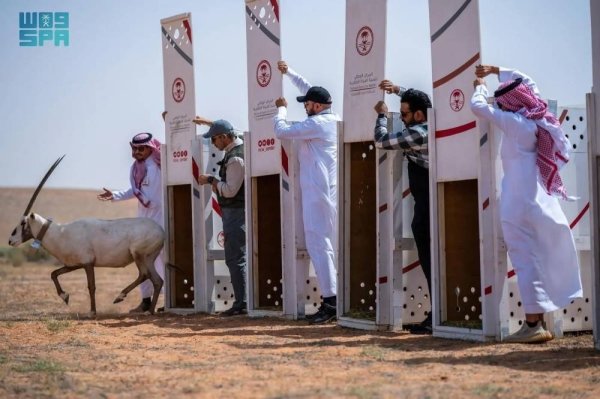25 endangered species released into Imam Turki bin Abdullah Royal Reserve

Saudi Gazette report
RIYADH — A total of 25 endangered native species were released into the Imam Turki bin Abdullah Royal Nature Reserve. The initiative was carried out by the National Center for Wildlife, in cooperation with the Imam Turki bin Abdullah Royal Nature Reserve Development Authority.
This initiative is part of the ongoing efforts to breed and reintroduce endangered species into their natural habitats. The released animals included five Arabian oryxes, 15 sand gazelles, two steppe eagles, and three Egyptian vultures. This action aligns with the center’s mission to reintroduce native species, restore ecological balance, and enrich biodiversity within natural reserves.
The release marks a continuation of the center’s nation-wide efforts to rehabilitate ecosystems and implement breeding programs for endangered species. These efforts contribute to the goals of the National Environment Strategy and support the objectives of the Saudi Green Initiative, reflecting the Kingdom’s vision for protecting natural resources and promoting their sustainability.
124 houbara bustards reintroduced into King Salman Royal Reserve
The King Salman bin Abdulaziz Royal Reserve Development Authority has reintroduced 124 rare houbara bustards across the reserve. This comes as part of the authority’s ongoing efforts to release numerous endangered species into natural habitats within the reserve, carefully monitoring their condition, and recording their data through a field team.
The houbara bustard nests in open ground, forming a shallow, unlined hole, often located near a short shrub. Its length ranges from 55 to 75 cm. Male houbara bustards weigh between 1,800 and 3,200 grams, while females weigh between 1,200 and 1,700 grams. Its range of movement in search of food is 60 km per day, and it feeds on grains, plants, insects, and worms.
The King Salman bin Abdulaziz Royal Reserve is the largest wildlife reserve in the Middle East, covering an area of 130,700 square kilometers. The reintroduction programs for endangered species confirm the authority’s commitment to its ongoing efforts to enrich biodiversity and conserve species whose numbers have declined due to factors including environmental pressures and loss of vegetation cover.
Source link



